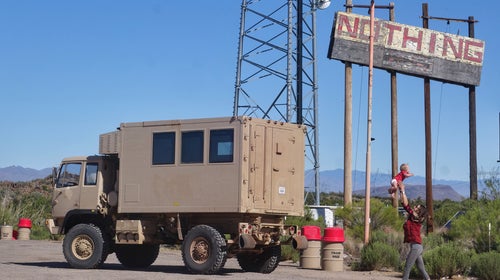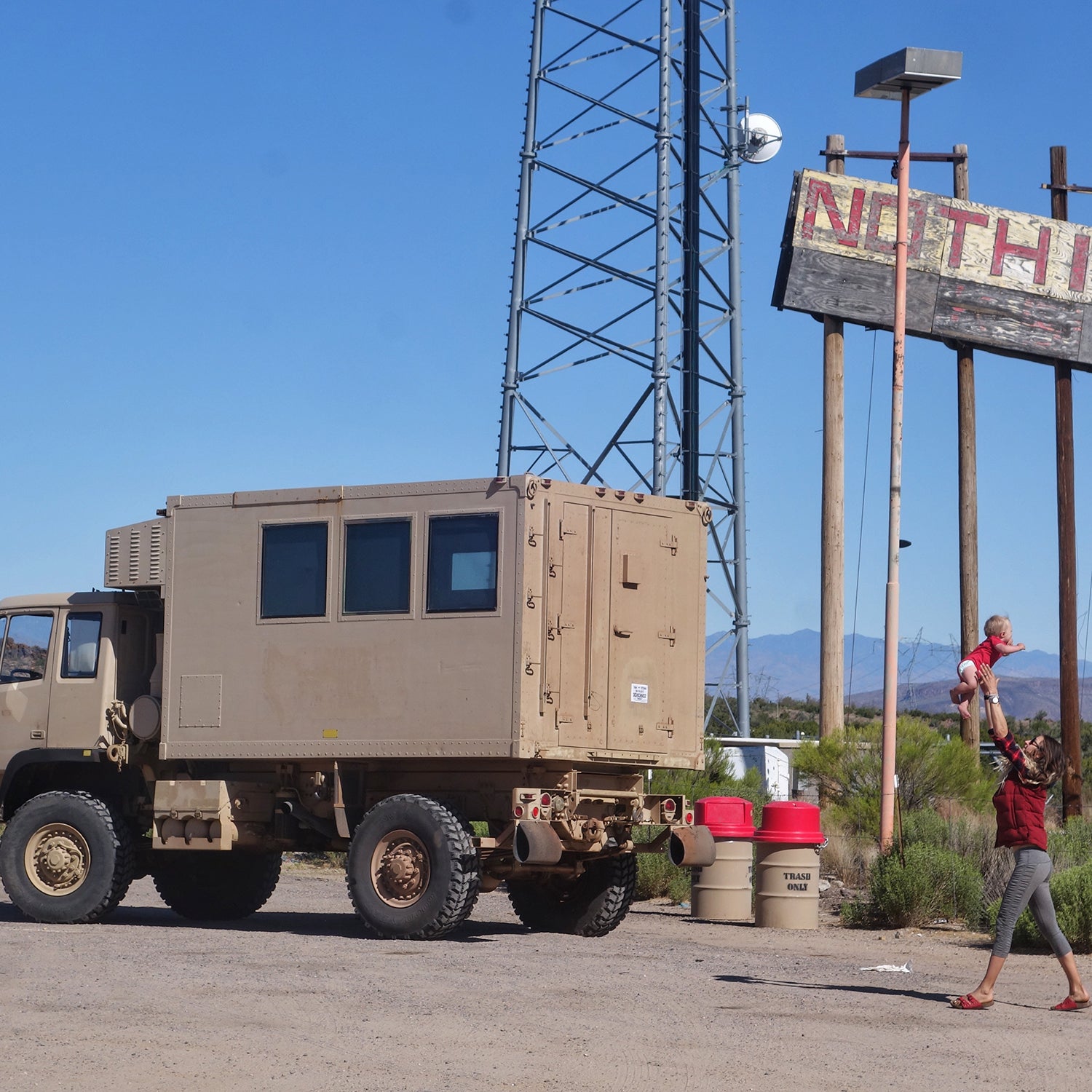Looking for a truck that’s big enough for a family to live in, but still has true go-anywhere off-road capability? You could spend $100,000-plus on a purpose built rig. Or, my wife, Rachel, and I thought, you could spend a couple grand on a decommissioned military truck.
Meet the LMTV
It stands for . But remember we’re talking military terminology here, so in this case “light” actually translates to a curb weight over 19,000 pounds. To put that in perspective, a four-door Jeep Wrangler weighs 4,000 pounds.
Like pretty much all the U.S. military’s equipment, the LMTV is made in America. It’s powered by a 6.6-liter Caterpillar turbodiesel engine that sends power to all four wheels through a seven-speed Allison transmission, which is similar to commercial items used in big rigs and construction equipment. In other words, they’re designed to last a long time while working hard.
Our truck is the van version of the LMTV—designated the M1079—and was meant to be used as a radio communications vehicle. Only about one in 50 LMTVs is configured like this. The big aluminum box on the back has five huge windows that open for ventilation, and come equipped with blackout shades. The 47-inch tires are equipped with a built-in inflation system that allows the driver to air them up and down with the push of a button. That’s a huge time saver when it’s time to get back on the highway (which requires high tire pressures) after a few days playing in the sandy desert (low pressures).
Why Buy One?
Rachel and I had been planning to drive our 1987 Toyota 4Runner down to Tierra Del Fuego at the southern tip of South America. That was before our son, Wilder, came along last September, and before we decided to adopt a third dog. In order to keep traveling, we needed to find a larger vehicle. Something we could sleep, cook, and shower in.
We started considering the options. Would a four-wheel drive van be big enough? Could a school bus go off-road? Did it make sense to tow a trailer?
To help narrow the choices, we created a list of must-haves: secure seating for at least three, possibly four, humans; room for the dogs; diesel power for better fuel economy; at least 80 square feet of living space; and four-wheel drive for go-anywhere ability. And it couldn't cost more than $50,000, including the build-out.
That last factor ruled out a Mercedes Sprinter, quad-cab Mitsubishi Fuso, and more exotic, custom-build off-road RVs like those made by Earthroamer or Sportsmobile. So we turned to the LMTV.
How Do You Buy One?
Buying an old military truck isn’t as straight forward as buying a normal used car. The most common way people acquire them is through an online military surplus auction, but that’s a process filled with potentially ruinous pitfalls. While numerous photos of each vehicle are included in each listing, as are the results of a perfunctory inspection, most of the trucks sold aren’t in running condition, and require a tractor trailer in order to collect them from the auction site. (Expect to pay $3 per mile for shipping.) Once you’ve gotten the vehicle home, getting it into roadworthy condition, and getting it registered, will likely prove extremely time consuming and expensive.
That hassle has created a cottage industry for resellers, who buy the trucks at auction for prices sometimes as low as a couple thousand dollars, perform the minimum work required to get them road legal, then turn a healthy profit by selling you a drivable machine. We went that route, purchasing an LMTV from a reseller in Maryland for $23,000.
Six Months and $45,000 Later
From that moment on, we entered a half-year crash course in mechanics and industrial interior design.
Getting the truck from Maryland to Seattle was our first lesson and challenge. In this case, we phoned a friend, who thought the idea of driving a truck with a 55-mile-per-hour top speed coast-to-coast sounded like a good time and offered to fly out and get the LMTV for us. He checked the fluids and tire pressures, handed over our cashier’s check, and met us in Flagstaff, Arizona, at the Overland Expo, six days later.
From there, we wound our way back to the Pacific Northwest, taking 4×4 trails whenever possible. We crossed sand dunes, forded rivers, and slept on our inflatable sleeping pads in the back of the truck. LMTV life felt good all the way to a truck stop on the outskirts of Bend, Oregon, where the alternator failed. A new one cost 10 days and $900.
Once we got the truck home, we began stripping it down to turn it into the RV we wanted. Inside, we got rid of the avocado green paint and the bright, buzzing 48-inch fluorescent lights. 500-pounds of steel plates bolted to the floor got in the way of our insulation and wood flooring, so I ground off its two-inch-thick bolts and tugged the plate out the back door. We built a queen-size bed platform, stainless steel counters, a sink, shower, and installed a hot-water heater.
Next, we needed off-grid power. The truck's roof was big enough to hold two commercial-grade 435-watt solar panels from . The electricity they produce is fed through a Victron solar charge controller, and stored in four 100 amp-hour AGM batteries. That powers the water pump, fridge, and lighting, with enough left over to run a chop saw and charge batteries.
Building the interior was way easier than fixing the truck itself, where even seemingly routine upgrades took on biblical proportions. Take swapping out the 24-year-old tires, our first big project after replacing the alternator. A new tire runs $1,500, and you need five. (The LMTV has a full-size spare mounted on a hydraulic lift behind the cab.) Fortunately, we found a seller offering new old stock tires for $300 a piece. Shipping five up north was just $587 for all of them.
Of course, mounting those behemoths was nothing like putting a new set of rubber on a passenger car. Lacking the military’s specialist tools, I resorted to an angle grinder to cut the old tires’ beads off the rims. Loosening the lug nuts took 500 pound-feet of force. The whole project took most of a week. Pay someone else to do it and it’ll cost you $100 per hour, at five hours of labor per wheel.
I also did some other basic maintenance. For unknown reasons, the military specs motor oil in the transmission, so I replaced that with actual transmission fluid. The 6.6-liter engine takes 6.5 gallons, or $150, of oil. After sitting for so long, I figured it was a good idea to go ahead and replace all the other fluids and filters, too.
Since then, we’ve also insulated the cab for sound and heat. Yet with such a big motor sitting directly under our seats, the noise cancellation is negligible, and without AC (not a standard feature of the LMTV), the insulation really just prevents the cab from getting overly hot when the engine's running.
What’s that all add up to? Getting the truck home ended up costing us $5,000. The initial build-out, the new tires, and the other basic maintenance added another $7,000. At this point, the truck wasn’t quite where we wanted, but I thought it was at least livable, safe, and reliable.
Then, while driving over a mountain pass a couple weeks after completing all that work, the oil light came on. We pulled over, and noticed that a sm��������line had blown, emptying five gallons of oil before we’d stopped. It took us a few days to get a new line custom fabricated in a small mountain town. I thought that was the end of the issue, but eight miles later, the engine dropped a valve, cracking the head. Coolant and oil poured out of the truck as we stood watching helplessly.
Towing the LMTV to a shop capable of working on it cost $703. Through social media, I found another owner willing to sell me a low-mileage used engine for $3,700, and shipping that here was $686. Pulling the old motor and dropping in that new one should be $3,500. New fluids, seals, and some other miscellaneous parts will be $800. A Caterpillar machine shop is doing that right now.
So…Is The LMTV Worth It?
As much work and headache as it has given us, we love this truck. It’s a true go-anywhere, do-anything, live-in-the-back vehicle with unlimited potential. It’s fun to drive, and the project of building it into our home as a family has been a great experience.
The dollar signs have been adding up faster than we planned, but I still think the LMTV makes sense—for us. Let’s compare it to the cheapest viable alternative—a Sprinter 4×4 converted into an RV—so you can see my thinking. A fully built-out Sprinter van getting 19 miles per gallon would have cost us at least $30,000 more than where we stand now. Probably close to $95,000 total to really get it nice inside.
Given the global average price of diesel fuel (about $3), a circuitous route from Prudhoe Bay, Alaska, to Tierra del Fuego, Argentina (about 20,000 miles, and our plan for next year), driving a Sprinter would cost $3,200 in fuel. Taking the 8.5 MPG LMTV will use $7,100 in fuel.
Given the huge difference in purchase price, we would have to make that trip eight times for the Sprinter to break even, and we wouldn’t have anything like the living space of the LMTV.
Of course, it's not for everyone. A machine like this will require enormous amounts of work and it won't be easy to find people to service it. But, if after ��������those caveats, you're still interested in one of these things, then read on about how you can make the process a wee bitt better.
Learn from Our Experience
We bought our truck from a mediocre reseller, where only the absolute minimum work had been done to get it rolling. That’s what led to the maintenance backlog—and the blown engine. At the time, we thought that was our only option given our budget, and pressing need for a larger vehicle.
What I wish we'd been able to do was buy a totally restored truck from well-respected , based in Bend, Oregon. They buy the trucks at auction, then go through them nut-and-bolt to improve their reliability and drivability. A ready-to-go LMTV from Grigsby will set you back about $50,000. That’s about equal to our total investment, just with an awful lot less headache. Grigsby can also help maintain your LMTV, and build it out into your ultimate overland RV.
What’s Next?
Once this new engine is finalized, we’re heading to Colorado, where we plan to spend the winter in our family’s barn, completing the rest of the build out. We plan to hit the road full-time next fall with really only one date in calendar: July 2, 2019, for the total solar eclipse in Chile.
After that: Who knows?


